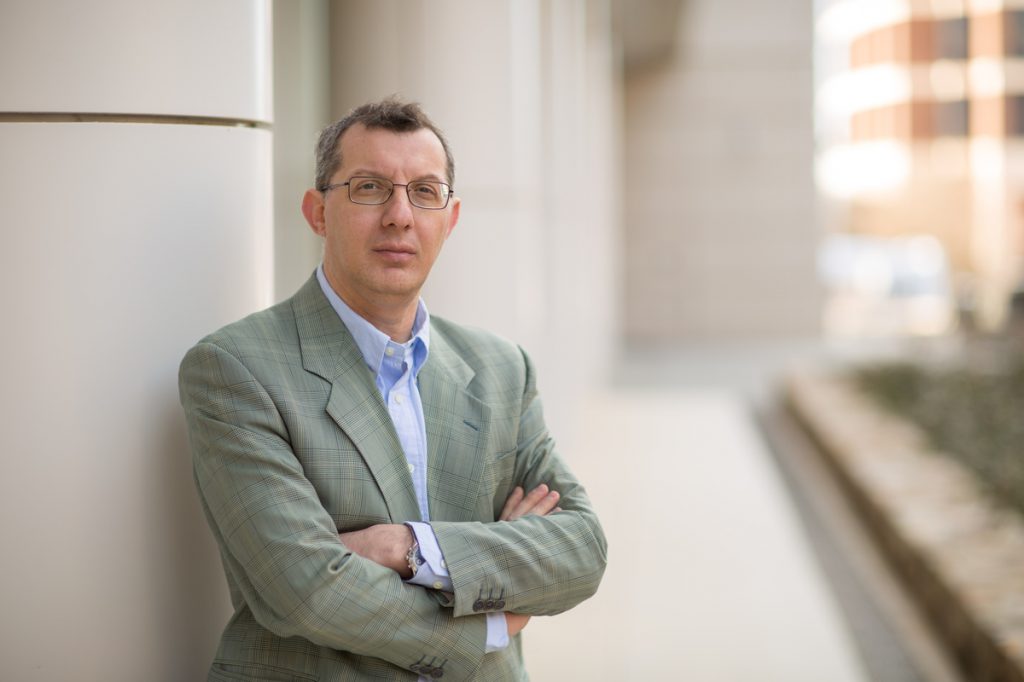Pairing a newly developed gel with immunotherapy that was delivered to post-surgical mouse brains with glioblastoma, a highly malignant and deadly cancer, improved the immunotherapy’s effectiveness, report researchers from the University of North Carolina Lineberger Comprehensive Cancer Center and colleagues. The findings appeared Oct. 6, 2021, in Science Advances.
The researchers used CAR-T cell (chimeric antigen receptor-T cell) immunotherapy, which involves harvesting immune-system T cells from a patient and genetically re-engineering them in the lab to recognize targets on the surface of cancer cells. In this mouse study, the CAR-T cells and gel were placed to fill in the area where a glioblastoma tumor had just been surgically removed. Previous studies have shown that administering T cells alone has produced limited benefit.
Glioblastoma is an aggressive tumor that can form quickly in the brain and is diagnosed most often in people in their sixties. Only 40 percent of people live for one year after diagnosis; just 17 percent survive for two years. Surgery is the first treatment used but presents many challenges in removing the tumor while also allowing for wound healing.

“We developed a gel made of fibrin, a protein most often associated with helping blood to clot. Applying a gel substance to an area of the brain to aid CAR-T cell therapy is unique in glioblastoma treatment,” said Edikan Ogunnaike, PhD, a biomedical engineer at UNC and first author of the article. “The gel aided CAR-T cell distribution in the brain by acclimating the T cells to the post-surgical wound environment while also stopping the tumor from recurring.”
The researchers used concentrations of human fibrinogen, a protein produced by the liver, which was transformed to fibrin with enzymes to develop a porous gel that was mixed with CAR-T cells and placed in the post-surgical brain area. The gel created web-like fibrin scaffolds in the brain, in which the CAR-T cells uniformly enmeshed themselves into the pores of scaffolds. The scaffolds are biodegradable and do not cause inflammation, tissue death or scarring.
Nine of 14 (64%) mice that received the gel and T cells were tumor free 94 days after treatment, compared to two of 10 (20%) mice who only received T cells. The researchers said if these findings can be replicated in human studies – they caution that many early laboratory findings don’t lead to clinical studies or new therapies – it would result in a great improvement in current treatment rates.

“Our approach was beneficial in glioblastoma and we believe that it could also control growth or return of tumors in the brain, eye and other organs,” said Gianpietro Dotti, MD, professor in the UNC School of Medicine Department of Microbiology and Immunology, co-leader of the Immunology Program at UNC Lineberger and corresponding author of this article. “It should be noted that direct delivery of CAR-T cells into a post-surgical area must result in broad coverage of the surface of the surgical cavity to maximize the possibility that T cells come in contact with residual tumor cells, which is where our flexible scaffold has shown to be of great benefit.”
The investigators are currently looking at injecting CAR-T cells to other parts of the brain. The process is being tested in pilot clinical studies to assess safety as well as to see if it elicits a greater distribution of CAR-T cells.
“We hope that our gel will provide antitumor activity over an extended period of time after surgery in patients without inducing toxicity, which seems to be the case in mice,” Ogunnaike said. “The gel might also allow for local delivery of other biological agents that could sustain T cell growth and counter suppression of an immunotherapy.”
Authors and disclosures
In addition to Ogunnaike and Dotti, the paper’s other authors at UNC include Alain Valdivia, Mostafa Yazdimamaghani, PhD, Ernesto Leon, Seema Nandi, PhD, Hannah Hudson, Hongwei Du, PhD, Simon Khagi, MD, Barbara Savoldo, MD, PhD, Frances S. Ligler, PhD, and Shawn Hingtgen, PhD. Zhen Gu, PhD, is at the University of California, Los Angeles and Zhejiang University, China.
The Microscopy Services Laboratory, Department of Pathology and Laboratory Medicine, were supported, in part, by a P30 CA016086 Cancer Center Core Support Grant to UNC Lineberger. In addition, the research was supported by National Cancer Institute grants T32CA196689, R25NS094093, R21-CA229938-01A1, U01CA239258, and by an Alfred P. Sloan Foundation SSMN grant.
Dotti, Savoldo and Du hold patents in T cell engineering. Dotti serves on the scientific advisory board of Bellicum Pharmaceuticals and Catamaran. Savoldo and Dotti are consultants for Tessa Therapeutics. Gu is the scientific cofounder of ZenCapsule, Zcapsule, and Zenomics. The other authors declare that they have no competing interests.
